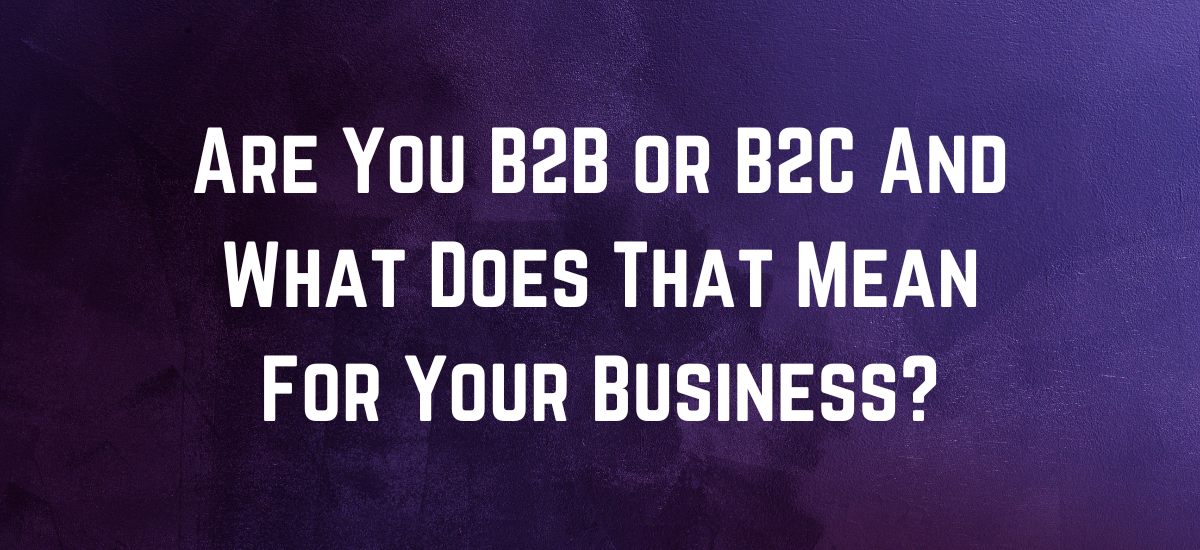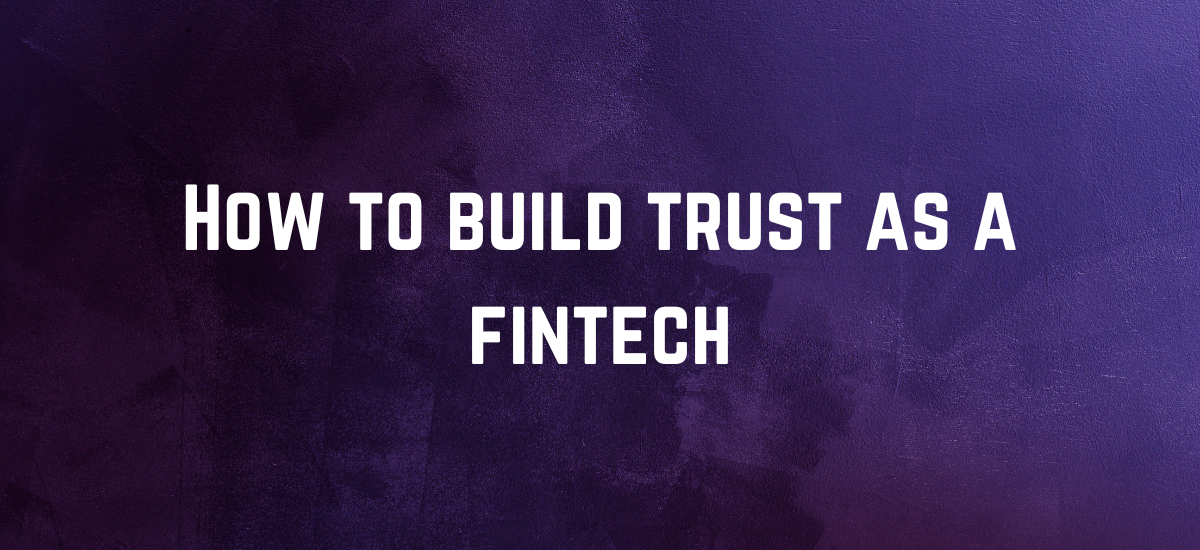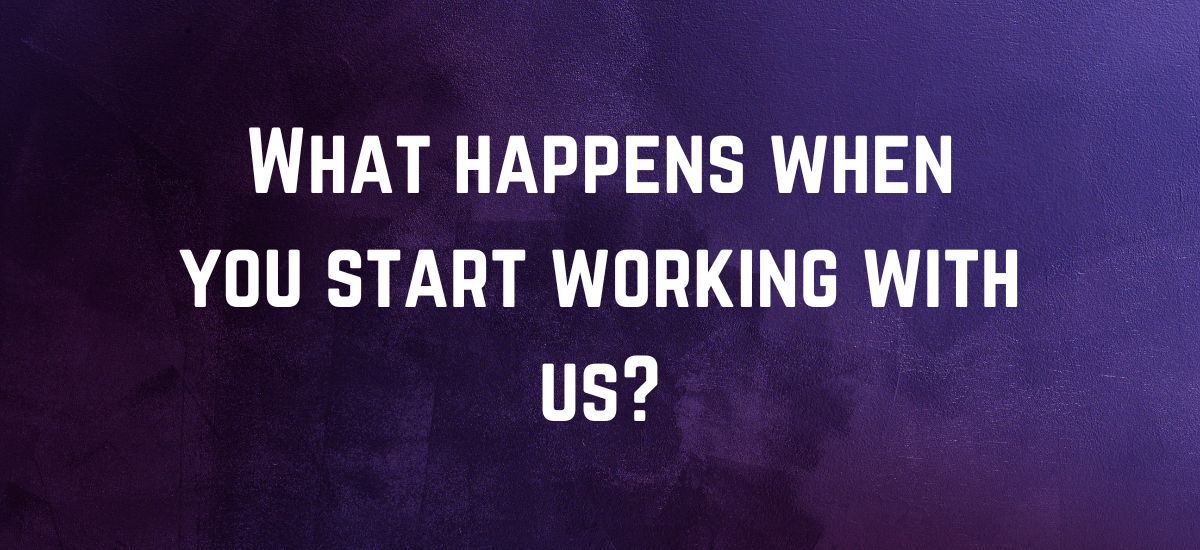by deborah
Share
by deborah
Share

B2B
B2B stands for business to business. B2B businesses service or sell to other companies. The people B2B marketers are selling to buy things on their company’s behalf. B2B companies include Funding Circle, Finastra, and Tide.
B2C
B2C stands for business to consumer. B2C companies focus on the individual consumer. Their marketing, products, and services are focused on the end user. B2C companies include Klarna, ClearScore, and Monzo.
Mixing it up
Many businesses fit into both. This can make their marketing a little more complicated. The use of multiple social media accounts targeting different demographics and clever paid social are some of the techniques these businesses use to manage this. Another strategy can include focusing on your B2C marketing and driving a strong brand presence that attracts B2B clients without directly marketing to them. Some examples of companies who service both include Starling Bank, Transferwise, and Revolut.
Why Should You Care About the Difference?
While there are many similarities between them, successful marketing as a FinTech depends on you understanding your target audience and buyer. This understanding can help you gain insight into the motivations behind your target market.
Think of the purchases you make in your everyday life, the things you buy for yourself or your family. Then, consider purchases you make on behalf of your business. Think about the motivations behind your purchases on both occasions. Often, we purchase things for one of several reasons:
- The item will make our life easier
- We think it will make us look better in the eyes of others
- It solves a problem we’re facing
- It helps us achieve our personal goals
- It will improve our lives in the long run
- It makes us feel like we’re a part of something bigger than ourselves
- It gives us a way into a community we would like access to
These motivations are true for B2B and B2C purchases, but the environments in which these motivations occur are different. Let’s take apart two separate purchase and look at the motivations behind them.
Scenario A: Katie wants to make her family happy by getting a new promotion. A new promotion would mean more money, more security, and more pride from her partner and children. Katie thinks her promotion will make other people see her as more valuable. Katie walks into a clothing store. She sees a beautiful, successful-looking model up behind the counter. The model is a conference room, and she’s leading the group. The model is wearing an outfit with a very bold print. Everyone else is wearing black. The model stands out, and she’s been rewarded for it by taking the seat at the top of the table. Katie buys the bold print rather than the black one hoping it will help her stand out at work and take her one step closer to the promotion and the respect of her family.
Scenario B: Katie is at work. She still wants a promotion. Her reasons for wanting a promotion are the same, but now she’s at work surrounded by her work colleagues. Katie has a big project coming up, and she has to decide between two consulting firms to help her. One is a thirty-year-old firm that charges a fortune but has a strong name in the field. The other is an exciting challenger firm that charges half the price. It’s only been around for two years, but it’s an impeccable track record. The track record of the older firm, when you look into it, is not actually that great. The older firm uses lots of indigo blue in their presentations and images of people working in offices dressed smartly. The younger firm uses fresh pastel colors and more funky graphic designs. Katie goes for the older firm.
Her motivations behind each purchase were the same, and so were the branding decisions of each company. Deeper than the promotion is her inspiration to make her family happy, provide for her loved ones and feel the respect of their confidence in her decisions. However, her decision for each was different. With the B2C purchase, she went for the choice that felt bolder. With the B2B purchase, she went for the safe-seeming one, despite its poorer track record and more expensive price tag. Katie was willing to bet on a riskier outfit choice but not on an up-and-coming business.
Despite playing on a similar need, the marketing team of each company would be better off going for different branding. Understand who you’re selling to, and you’re already halfway to great marketing.
The similarities
While there are several differences between B2B and B2C marketing, they can learn much from each other. Traditionally, in financial markets, B2B businesses will dismiss many of the most successful forms of marketing by assuming they’re only for B2C marketers. A great example of this is influencer marketing.
Influencer Marketing
Influencer marketing has taken the B2C world by storm. But financial markets, both B2B and B2C, have been slow to adopt this form of marketing and in some circles, are quick to belittle it.
B2B businesses have been even quicker to dismiss influencer marketing. However, influencer marketing actually fits in very well with the financial markets’ business to business way of doing things. Who you know, and what they think of you has a big impact in the financial services industry. While the right friends aren’t everything, they do get you in the room.
When Covid-19 hit, there were no more rooms to get into. Everything went digital. Influencer marketing is a way to take the B2B FinTech way of doing things, put it on a digital platform, and scale it. Now, who you know could be in the open for everyone to see.
When I was 16 and eavesdropping, I remember hearing bankers talking about the powerful effect of LinkedIn. I thought it sounded like Facebook but for older adults. I was wrong. Facebook is now Facebook for older adults, and LinkedIn is your key to the business world, even if you have social anxiety.
Don’t know how to talk to people? Don’t like going outside? No problem, you can connect and network with financial services businesses worldwide from your living room, and influencer marketing is the way to do that.
Bottom line is, like 16-year-olds on TikTok, business people often trust the people they look up to in the industry more than they trust an advert that pops up on their social media.
Build Relationships with Your Marketing Funnel
Another place B2B and B2C intersect is that they should both be using marketing to build relationships with their buyers. There are multiple touchpoints to your marketing. This is usually called the marketing funnel and varies from business to business. The general view is that the funnel starts with awareness, goes on to interest, then into consideration, and finally on to conversion. I think there should be an additional layer after that, retention. Think of your marketing funnel as a formal way to make a friend. To first make a friend, they have to meet you. This usually happens in the open, at a party, or through another friend.
This is your awareness level, and it’s just getting your name out there. Good ways of getting your name out there include creating educational content that is of interest to your audience, then distributing that content through various paid and organic channels, anywhere your audience is. The content should not talk too much about your product or service.
The next layer is interest. This is where you’re getting to know each other. For both B2B and B2C, the interest layer includes more detailed content that introduces what you’re offering.
Potential buyers then move on to consideration. Consideration includes case studies, offers, price comparisons and free trials. While case studies will look very different for B2B vs. B2C, there should be careful attention from both sides. B2C should aim to get reviews both on their own channels and externally in video and written format; B2B should work on building out official case studies their potential clients can review when making a decision. After that comes conversion, the conversion layer is really just about getting out of the way of your customer purchasing. For B2C, the conversion marketing can include tactics like shopping cart abandonment follow-ups or ensuring that purchases are a seamless experience. For example, let’s say someone gets halfway to signing up for your online digital bank, but maybe an annoying pop-up won’t go away at that moment. They try to click backspace, but instead of removing the pop-up, it sends them back to a previous page where they have to re-enter all of their details. They think this isn’t worth it and decide not to sign up. We’ve all experienced website issues like this, be sure to check that your purchasing experience is seamless.
While the rest of the funnel looks very similar, the conversion layer differs significantly between enterprise B2B and small-ticket B2B or B2C. This is because often, with enterprise B2B purchases, if you’re selling something that costs a lot of money, it might be done with the sales team, and procurement might get involved. Consider all the players involved in pushing through a deal, and then think about which one’s it’s financial beneficial to target with your marketing.
One small comment is that if you are a B2B company that sells something under the £200 mark, it can sometimes benefit you from a marketing perspective to act like a B2C company.
Lastly, there’s retention. Retention is often ignored, but it should be just as crucial to the marketing team as it is to the account management team. Retention marketing is just trying to make your buyer feel like they’re part of a community after they’ve purchased. This can be done through several means. For example, you could invite them to exclusive events. These are very useful; as if the events are valuable to your buyers in and of themselves, they can become part of the reason for working with you. Another way to create a buyer community is to send out buyer-specific newsletters. If you use this tactic, remove all buyers from your prospect newsletter to ensure they aren’t overwhelmed with emails. Another technique is to create a private Facebook group, Slack, or LinkedIn group for post-purchase. Fill it with fun videos, let buyers talk to and help each other, answer the questions any of your buyers have and post unique, helpful content that helps improve their experience once they’ve purchased. Occasionally, you can also use this group to upsell to a community of people who already know and like your brand.
The timing of these layers can move quickly or slowly, depending on the situation. For example, Experian recently launched an advertisement in the UK. The advert grabbed its audience’s attention by showing a man in a dentist’s chair about to launch into space. It then moved the audience into interest within the same advert by saying you could immediately increase your credit score. You could then sign up for an account and start using Experian® Boost for free, making the consideration stage easy to access. Within the site, after signing up, you could purchase a monthly subscription to Experian CreditExpert®, which would help you build your credit score further and protect yourself from fraud. Experian then helped retain their customers by providing a great product that helped them develop their finances for their future life.
It generally takes 3 – 6 touches for you to convert someone into a client, so however long your funnel is, ensure you’re not just showing adverts once to your prospects and then stopping. The real magic happens when you retarget.
Connect on an emotional level
Business buyers are people too. Whether you’re working on content marketing or social media, remembering to connect on a personal level with both B2B and B2C buyers. What are your buyers motivations behind purchasing your product? Music, nostalgia, and shared experiences are great ways to connect to your buyer emotionally.
The differences
The differences between B2B and B2C marketing are far fewer than expected. Many successful B2B businesses get their marketing strategies from copying B2C campaigns. However, here are some.
Time
The main difference is time. Marketers are always talking about people’s short attention spans, and it’s true; the faster you can make the delivery of your information, the better. However, it’s also true that much of marketing happens where we find our entertainment; our phones, the television, and social media.
We have infinitely more time for these things, particularly for anything that is genuinely entertaining and takes place on a medium we feel comfortable with. While delivering B2C FinTech products to the consumer market, as long as you make your marketing fun or educational and, most importantly, simple, you can take up much more time than marketers traditionally suggest.
The timing is different for B2B. B2B people are often at work or hearing about work outside of working hours. They may be about to go into a meeting or trying to spend time with their family. Be careful of how you time your campaigns; for example, you might prefer to narrow the timing of a Google ads campaign to working hours if you’re targeting a junior person, as they may have been allotted a certain period to research new tools. Consider when and how your target audience looks for the information you’re providing.
Price
The lifecycle and the actual cost of advertising can be more expensive when marketing B2B. Fun, exciting tools such as TikTok provide advertising options for smaller budgets and are great for B2C companies testing the waters. B2B companies testing the waters have fewer, much more expensive options.
You may also face multiple touch points; for example, procurement, finance, and senior leadership may all have a say in purchasing your tool or service. In B2C, you usually target and sell to one person. They may ask their partner or family, but that’s less of a block than an entire department having to sign off on something.
The pricing is also affected by the timing. If you’re launching a B2C product, you might use TikTok to test the advertising waters. You could put in £100, and if you don’t make £300, you have accurate data to help you decide on your marketing spend strategy. On the other hand, if you’re a B2B company, you could spend £20,000 on advertising, but the purchase lifecycle might take up to 6 months, so you’re waiting much longer to get the return on your investment, and your insights into the market are slower.
A Note: Don’t make the mistake of thinking that exclusively targeting CEOs will help you lower your marketing costs if you’re B2B. CEOs often have less of a reason to buy something than their team. They may forward an ad or email to the appropriate person, but no one wants to feel like their CEO is shoving a product down their throat. CEOs are very busy, very expensive to market to, and do not just tell their teams what to purchase. They are leaders, and their job is to lead, not to decide which CRM tool to use.





